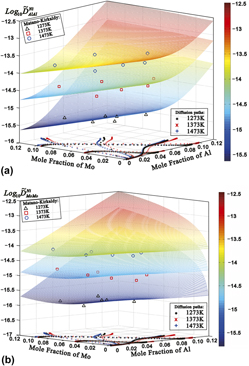Article contents
High-throughput measurements of interdiffusivity matrices in face centered cubic Ni–Al–Mo alloys at 1273–1473 K
Published online by Cambridge University Press: 13 February 2017
Abstract

Based on 15 diffusion couples located in face centered cubic single-phase region of ternary Ni–Al–Mo system, high-throughput determination of composition-dependent interdiffusivity matrices at 1273, 1373, and 1473 K was performed by using the recently developed numerical inverse method. The determined main interdiffusivities over the investigated composition and temperature ranges are all positive, and
 $\tilde D_{{\rm{AlAl}}}^{{\rm{Ni}}}$
is generally larger than
$\tilde D_{{\rm{AlAl}}}^{{\rm{Ni}}}$
is generally larger than
 $\tilde D_{{\rm{MoMo}}}^{{\rm{Ni}}}$
. Moreover,
$\tilde D_{{\rm{MoMo}}}^{{\rm{Ni}}}$
. Moreover,
 $\tilde D_{{\rm{AlAl}}}^{{\rm{Ni}}}$
generally increases with concentration of Al, while
$\tilde D_{{\rm{AlAl}}}^{{\rm{Ni}}}$
generally increases with concentration of Al, while
 $\tilde D_{{\rm{MoMo}}}^{{\rm{Ni}}}$
increases with concentrations of both Al and Mo. In contrast, the cross interdiffusivities can be either positive or negative. Average relative errors of
$\tilde D_{{\rm{MoMo}}}^{{\rm{Ni}}}$
increases with concentrations of both Al and Mo. In contrast, the cross interdiffusivities can be either positive or negative. Average relative errors of
 $\tilde D_{{\rm{AlAl}}}^{{\rm{Ni}}}$
,
$\tilde D_{{\rm{AlAl}}}^{{\rm{Ni}}}$
,
 $\tilde D_{{\rm{AlMo}}}^{{\rm{Ni}}}$
,
$\tilde D_{{\rm{AlMo}}}^{{\rm{Ni}}}$
,
 $\tilde D_{{\rm{MoAl}}}^{{\rm{Ni}}}$
, and
$\tilde D_{{\rm{MoAl}}}^{{\rm{Ni}}}$
, and
 $\tilde D_{{\rm{MoMo}}}^{{\rm{Ni}}}$
were evaluated to be 2.4, 5.1, 16.1, and 1.7% using error propagation. Furthermore, our prediction of composition profiles and interdiffusion fluxes based on evaluated interdiffusivity matrices agrees quite well with measured data. Traditional Matano–Kirkaldy method was also applied to further verify the reliability of obtained interdiffusivities. Besides, three-dimensional planes of activation energies of main interdiffusivities were also evaluated using the Arrhenius equation.
$\tilde D_{{\rm{MoMo}}}^{{\rm{Ni}}}$
were evaluated to be 2.4, 5.1, 16.1, and 1.7% using error propagation. Furthermore, our prediction of composition profiles and interdiffusion fluxes based on evaluated interdiffusivity matrices agrees quite well with measured data. Traditional Matano–Kirkaldy method was also applied to further verify the reliability of obtained interdiffusivities. Besides, three-dimensional planes of activation energies of main interdiffusivities were also evaluated using the Arrhenius equation.
- Type
- Articles
- Information
- Copyright
- Copyright © Materials Research Society 2017
Footnotes
Contributing Editor: Jürgen Eckert
References
REFERENCES
- 20
- Cited by



